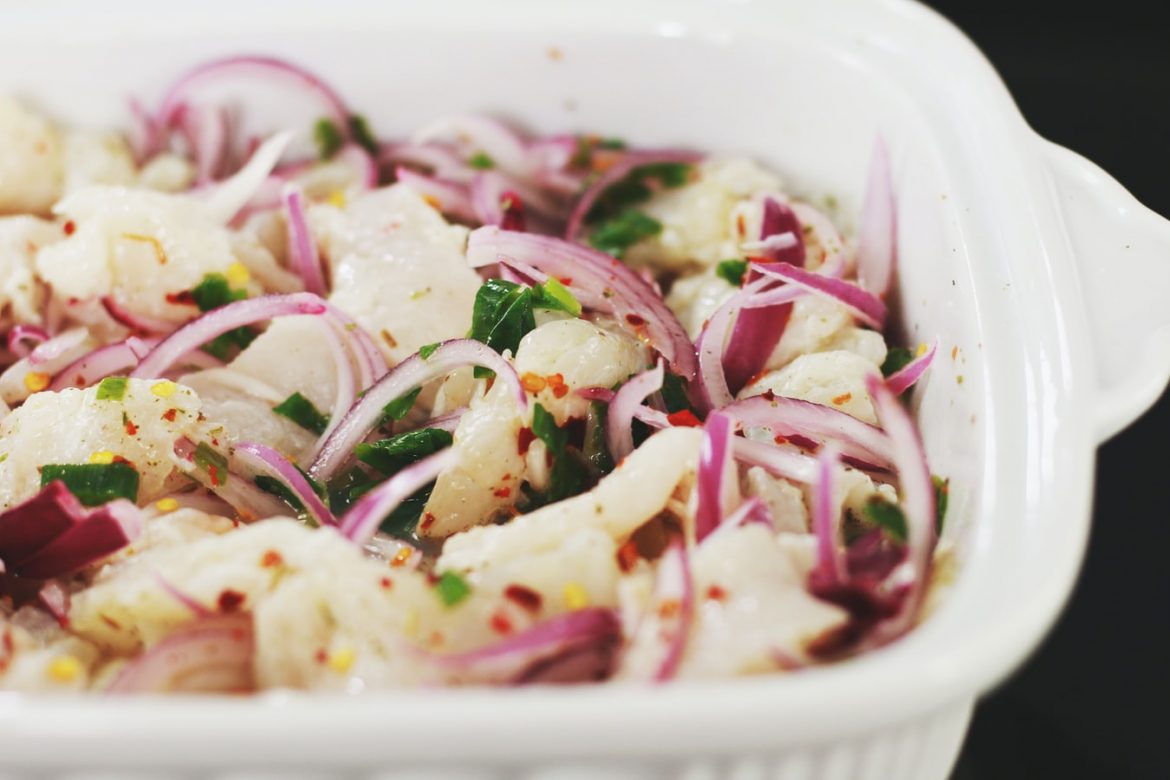If there’s ever an instant Chilean coastal pick-me-up, it’s the comfort and vibrancy of a chilled glass of coastal white with zesty ceviche. Helen J Conway explores this Latin American dish with the classic ceviche recipe and ideal pairings from Chile’s cool-climate coastal wine regions.
Close your eyes and imagine you are sitting on the sunny terrace of a restaurant. The Pacific Ocean is lapping gently against the nearby beach, which is deserted apart from a few oystercatchers and a seagull that occasionally rents the air with its cries. Five pelicans fly overhead in military-style formation before landing majestically on the fishing wharf to your left, where the yellow and blue wooden fishing boats are bobbing lazily up and down in the hot afternoon.
The waiter arrives with a bottle of beautifully chilled Chilean Sauvignon Blanc and a plate of ceviche. The marinated fish dish with its soft texture and salty-citrus flavour pairs superbly with the white wine, transforming this into one of those moments to be remembered…
The origins of ceviche (aka cebiche, seviche, sebiche) are shrouded in mystery – some historians believe that the recipe comes from indigenous traditions, while others consider it to be an Arabic dish that came to South America via Spain. But whatever its past, today this is one of South America’s best-loved dishes, served in restaurants along the length of the continent from Mexico down to Chile. Peru takes their ceviche so seriously, it has given the dish cultural heritage status and named 28th June National Ceviche Day!
Ceviche everywhere starts with the same base ingredients: raw fish, citrus juice (usually lemon or lime), sliced onion and salt. However, as with many much-loved dishes around the world, the final recipe varies from country to country and from kitchen to kitchen and of course everyone thinks their own particular recipe is the best.
In Mexico the raw fish is shredded, giving it an even softer, smoother texture that is contrasted by the fresh notes of diced tomato and cucumber and then pepped up Mexican-style with a generous helping of diced chilli peppers. Prawns are a popular ceviche ingredient in Guatemala while Venezuelan recipes often include mango. Chefs in Peru tend to cut the fish into small cubes and marinade it with salt, garlic, chilli peppers and lots of lime juice; and some serve it with sweet potatoes, sweetcorn and sometimes other seafood like prawns, octopus and lobster. In Chile, the fish is diced and a pinch of Chile’s typical smoked chilli powder, merquén, is often added to a lemon (or lime) juice marinade, along with diced coriander leaves.
But innovative chefs in all countries play with these traditional recipes and add and subtract ingredients, so don’t be surprised to find ceviche made with salmon, enhanced with coconut milk, or served with the purple and pink potatoes from Chiloé.
And, for those who don’t eat fish or just fancy a change, there is a really delicious and vitamin-packed vegan variant in Chile: ceviche de cochayuyo made from seaweed.
Wherever you go in the region – or even if you are armchair travelling in the comfort of your own home – what could be a more authentic South American experience than a plate of ceviche, a glass of cool, crisp white wine, the warm sunshine on your face and the fresh, saline breeze blowing in from the Pacific Ocean?
Wine pairings for ceviche
Ceviche has a salty-citrus flavour, acidic bite and lean texture, so it makes sense to pair it with a wine that will complement those aspects. With its zesty acidity and citrus fruit aromas and flavours, Chilean Sauvignon Blanc is an ideal choice.
Coastal Sauvignon Blanc can often have a saline note that will also pair well with that salty note in the ceviche and if you look at wines from the coolest coastal sites in Limarí or Leyda, you can often also get a herbaceous note of elderflower or artichoke and even a hint of green apple or pear, along with really taut acidity, perfect for a traditional style of ceviche.
Meanwhile Sauvignons from warmer areas like Casablanca, Elqui and Paredones can have more tropical fruit notes like pineapple and passionfruit, sometimes intermingled with a tantalizing aroma of chilli pepper that will combine well with the more spicy, tropical-influenced ceviche dishes.
And if you are looking for an alternative pairing, how about the firmer textured ceviche de cochayuyo with the fuller body of one of the fresh, saline, slightly chalky Chardonnays from coastal Limarí? Umami eat your heart out.
Chilean ceviche recipe
Ceviche ingredients (4 servings)
- 2 medium-sized fresh white fish, cleaned, boned, filleted and diced (pomfret and hake are common).
- 1 purple onion, finely sliced
- Several lemons, juiced
- Plenty of salt and pepper
- Bunch of fresh coriander, diced
- Pinch of merquén (or chilli pepper)
- An inch of ginger root, grated (optional)
How to make ceviche
Put all the ingredients into a container and cover them with lemon juice. Cover the container and leave it to macerate in the fridge for up 20 mins up to three hours (depending on how firm you like your fish). Strain the ceviche from the lemon juice and serve.
What’s your favourite ceviche wine pairing? Or do you have a favourite ceviche recipe? Share your comments with us below or on Facebook!
